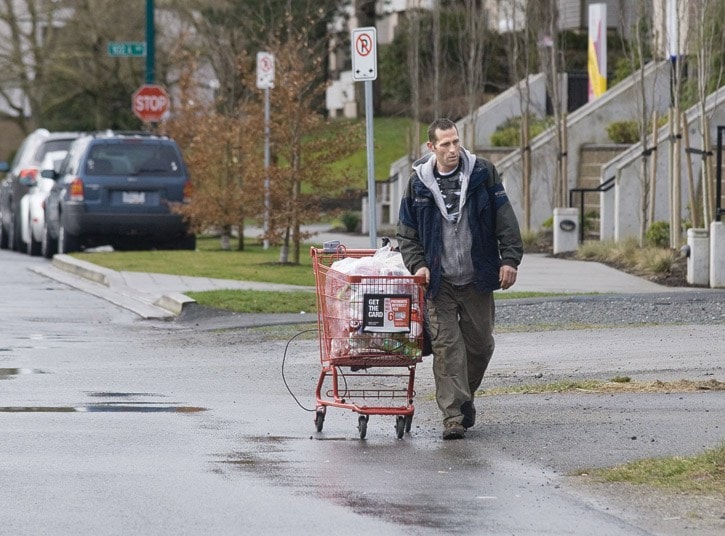Hauling a shopping cart full of plastic bottles and pop cans, he appears to be one of Surrey’s many homeless.
However, he’s clear-eyed and well-groomed, and has a wife and six-year-old twins at home.
Augmenting his income?
“This is my income,” sighs 38-year-old Sean Campbell. He lost his job with a scaffolding company a few years ago and has been on social assistance ever since.
The $700 a month he gets for housing doesn’t cover rent. Because the twins are opposite sex, Campbell says the government requires them to have separate bedrooms by age six.
His three-bedroom apartment costs him $1,000 a month, so he takes $300 from his $427 food and utilities allowance to cover the rest.
He collects bottles to pay for the utilities and the food the family needs.
The Surrey Food Bank, he says, is a tremendous support.
As far as homelessness goes, he says his family is “on the brink of it.”
He starts his day at 4:30 a.m. at Labour Ready to look for a job, then it’s out at 7:30 a.m. collecting bottles.
At 9:30 a.m. he’s off to the Employment Club for more job searching.
He doesn’t feel like much of it is making a difference, and says he’s likely going to receive a 10-day eviction notice because of back rent owed.
Campbell and his family are technically housed, so they won’t be counted as part of this year’s enumeration of homeless people.
The annual regional Homeless Count took place Wednesday – a one-day snapshot of the homeless conducted from midnight to midnight March 16.
Close to 100 volunteers hit Surrey streets with questionnaires to fill out in interviews with Surrey’s street homeless. The 20 questions include where they slept the night before, where they consider home and whether they have drug or alcohol problems.
Volunteers cycled through the Surrey Urban Mission Wednesday morning, handing in their forms, which will be tabulated by a consulting group over the coming months.
Surrey Urban Mission’s Jonquil Hallgate hopes the numbers are down this year, but from the services the mission provides, she notices a changing demographic.
Many of the people she sees are like Campbell, once gainfully employed, but now either completely homeless or at high risk of homelessness.
She also sees a lot more youth than she has in the past.
One 23-year-old who frequents the mission has been through 26 foster homes.
“No money, no life skills,” she says.
In April, the region will have preliminary figures on how many homeless there are in Metro Vancouver.
“It’s not about numbers,” Hallgate said. “It’s about determining how they got there.”
One thing she’s noticing is quite a number of tradespeople freshly out of work that are appearing for meals at the Surrey Urban Mission. Many of the younger ones have since found work, but the older ones are stuck without an income.
“The picture of poverty being a man with a long scraggly beard has long gone,” says Vera LeFranc, program director for the Surrey Homelessness and Housing Society.
All of the workers’ greatest hope is that the numbers drop.
“My greatest concern is that the numbers actually capture the number of people homeless,” said Candace Davidson, Manager of Client Services with the Surrey Food Bank. “If too much policy was based on a 24-hour count, that would not be good.”
Campbell’s greatest concern is that he can come up with rent soon, so that he and his family aren’t part of the next regional count.
kdiakiw@surreyleader.com
